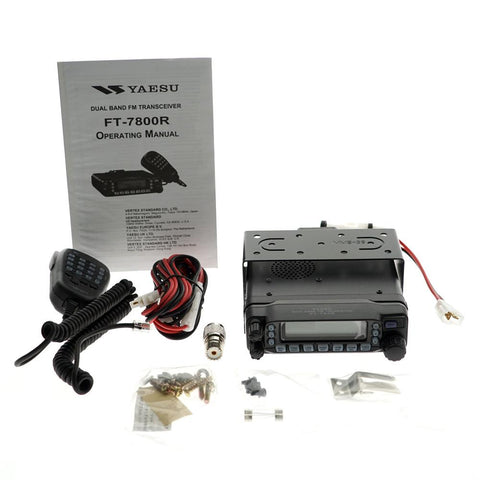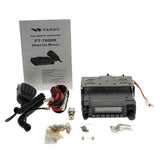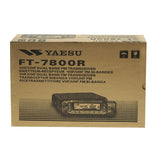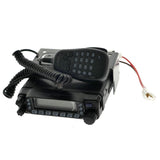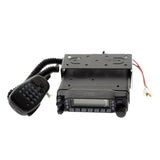The FT-7800R is a dual band 2m/440Mhz mobile radio. We won’t bore you with all the technical details. You can check the brochure yourself in the collateral files and images associated with this review.
This review will focus primarily on what is unique to this radio. The uniqueness of this radio and the price are the reasons we purchased it. The street price for the FT-7800R at the time of this writing is $265 from Amateur Electronic Supply.
Due to the wide receive range this radio is a good choice if you want to use this for traditional ham radio use (TX/RX) and if you like to listen to conventional analog transmission of public safety, business, and anyone else licensed to use the frequencies within the RX range of this radio.
Overview
The FT-7800R has 1,000 alpha memory channels, 20 memory banks, 50 band/scan edges, and a search and store feature. This is more storage and scan capability than any 2m/70cm mobile ham transceiver on the market at the time of this writing. The FT-7800R also has a set of 5 hyper memories that can store 5 different real-time radio configurations. The Hyper-memories are hard to explain. We’ll will leave that until later. Unique to this radio, and not even available in scanners, or most ham radios, is that the memory bank size is configurable and any memory can exist in any number of banks without wasting another memory location. Be reminded that the RX frequency range is 108Mhz-520Mhz, and 700Mhz-1Ghz. There is a lot of listening to be done here. More detail on each of these features is discussed below.
One Thousand (1,000) Memory Channels
Each of the 1,000 memory channels can hold a 6-character alphanumeric name. Each channel can be individually set to display the alpha name or the frequency. On some other radios, the radio can be set for alpha or frequency display and it applied globally to all the channels. To be able to set each memory channel for alpha or frequency is a real plus. For ham frequencies you may want to see the frequency; for scanner frequencies you might want to see the alpha display of the assigned use of that frequency. Whatever you want to see – frequency or alpha tag – on an individual basis, you can store in the individual memories on the FT-7800R.
Twenty (20) variable size memory banks
So now you have 1,000 memory channels. What do you do with these? Well, you put them in any of the 20 variable size memory banks
The innovation of this radio is that it has 20 variable size memory banks. That means that you can have a memory bank of size one or a bank of size 1,000. Most radios these days have fixed size banks and there is usually too few banks and they are too big. Most scanner people will tell you that a 1,000 channel scanner having 10 banks of 100 memory channels is really sub-optimal .
How do these variable size memory banks work? Its easy to explain if you can visualize a spreadsheet with rows and columns. Down the left side in the first column are 1,000 memory channels. Across the top of the spreadsheet are 20 columns for the memory banks. Place a check mark in rows and columns to place a memory location in any number of banks. Pick a row and put 20 check marks across all the banks and you have that same identical frequency in all the banks and you only had to store the frequency once. That is a very efficient use of memory space.. You don’t have to store a memory in a bank if you don’t want to -it’s accessible via the memory dial or direct entry from the microphone keypad.
The visualization of a spreadsheet is exactly the visual representation that the FT-7800R programming software from RT Systems uses to lay things out so you can assign the 1,000 memory channels to 20 memory banks.
Fifty pairs (50) of programmed band edge limits.
Like to scan lower/upper frequency limits looking for activity? The FT-7800R has 50 pairs of programmable band edge memories. The downside of limit scan is that the FT-7800R has no concept of frequency lockout. If you are scanner person you are going to expect this. It’s too bad the Yaesu engineers did not allocate some memory and programming support for lock-out frequencies. All is not lost, since you can use the timed-resume feature to get past frequencies you don\’t want to hear. But it is annoying. Planning the lower/upper limits small enough and you can avoid the birdies, control channels and other continuous transmission that you don’t want to hear.
Thirty (30) auto-load smart search memories.
The FT-7800R has 30 smart search memories. You set a frequency in the VFO and start smart search. The radio will search above and below this VFO frequency and store the active frequencies. For example, if you set the band to 2 meters and load 146.000 Mhz into the VFO and start smart search it will scan above and below 146.000 Mhz storing the first 30 active frequencies that it finds in these memories.
Hyper-memories
The FT-7800R has a set of memories, called Hyper-memories, that store a set of configurable radio run-time parameters. No other radio on the market at the time of this writing has this feature. The feature is hard to understand and explain but it is a powerful concept. Let me describe what you can do with these Hyper-memories. Suppose you had your radio scanning 2m repeaters that you stored in one of the 20 memory banks. You could store this fact in a Hyper-memory. Suppose you were scanning 70cm repeaters you stored in another bank. You could store this fact in another of the Hyper-memories. Now all you need to do is press one of the Hyper-memories and get the radio to do one or the other. This is a very simple example. Hyper-memories also store”skipped” channel information. You could set up Hyper-memories with all sorts of combinations of skip frequencies. It goes far beyond this. The Hyper-memory buttons are lighted, easily accessible buttons on the front of the radio. They are a convenient way to store 5 complex radio configurations and get them going with a push of a button. Maybe this is the intent of the marketing tag line “Back to basics”. Its one button simplicity after you set all this up.
Conventional Analog Scanning Capability
The FT-7800R can scan frequencies in a selected band-edge pair, a single memory bank, or any number of memory banks linked together. This last feature is very useful for compressing or expanding a search. For example, one bank can have 2m repeaters, another 70cm repeaters, a third GMRS frequencies, another Chicago Police, and so on. By planning your banks out and linking banks you can easily listen to exactly what you want. In fact, you can store these configurations in the 5 Hyper-memories and scan any of these variable configurations with the push of a single button.
There are two scan-resume settings. You can do a timed resume or a carrier-drop resume. This feature is global to the radio and can not be set on individual banks. This feature is very useful for monitoring all the conversations during scanning – if you are in to that.
Other scan features are preferred scan or skipped scan. You can mark memory channels in either of these ways and the radio will only scan preferred channels or skip channels marked as such. Again, very flexible. The radio can also do pre-programmed WX (Weather) scan and priority watch.
Attention Wal-Mart Shoppers – The Infamous Separation Cable
Now we\’re getting to the good part. The FT-7800R has a removable head for remote mounting. Yaesu wants about $58 for the separation kit which includes a cable and a mounting bracket.
Innovative Wal-Mart shoppers can achieve remote mounting for $8. I’m sure the Yaesu marketing guys, designers, and engineers that came up with remote mouting implementation have been fired by now. If you can’t make a lot of money on the radio, then make it on the accessories at the tune of $58 for the remote mounting kit. The ICOM guys did it “right”, from a profit perspective, on the ICOM 2710. You had to buy the expensive remote mounting kit since the the connector and the cable was custom. Yaesu implemented remote mounting on the cheap – they used a common 6-conductor telephony cable with RJ11 connectors. But they did it with a “twist” to try to out smart you. Just when you think you\’ve got the customer locked in to the expensive cable, Yaesu slipped and gave you the solution. They gave the”twist” back to you.
Bottom line, your separation cable for the FT-7800R is available at Wal-Mart for $8 in the form of a 7ft 6-conductor telephony cable with standard RJ11 plugs on each side and a 6-conductor inline adapter. Extend the existing short cable connecting the body to the faceplate with the inline adapter and the 7 ft telephony cable. A photo of the completed cable and a file with the part numbers and a description of how to make it and why it works is in the supporting files for this review.
Out of Band Transmit – MURS, GMRS, FRS, and others.
Yes, you will break the law. The FT-7800R is easily modifed to transmit out of band on all these frequencies and more. The FT-7800R is not type accepted to transmit on these frequencies but Yaesu has made it very easy to mod the radio for out of band transmit.
Excursus: A side note on removing surface mount components
We see a lot of people recommend removing surface mount components by de-soldering. This is a high-risk procedure. There is a much better low-risk way. We have done this low-risk procedure many times with 100% success. If there is no way you ever intend to put that same component back we recommend that you cut the component out or crush it. In the case of a surface mount diode, diode pack, or a multi-leg transistor you can easily cut the legs with a sharp X-acto knife. Just swipe the knife across the thin legs of the component about 10 times and you will cut right through it. If you like crushing things and the component is in the clear, use a nail clipper to crush the component. In both cases, these surface mount components are sometimes lightly glued in-place when they are picked and placed so they don’t move until the solder process gets them. So you might need to nudge them a bit after you have sliced their legs off or crushed them. Whoever told people to de-solder these surface mount components must be in the radio repair business and looking for work. Cut or crush beats heat any day. Do all of this at your own risk.
Miscellaneous Comments
- The marketing for this radio includes the tagline “Back to Basics”. This radio is complex to program. I found that I was constantly referring to the manual to do simple things. The front buttons on the radio do different things depending on how long you press the button. However, the 5 Hyper-memory buttons will get you five different configurations at the press of a button – if you can figure out how to program these special memories. Plan to spend some big time reading the manual and creating a cheat sheet for yourself on simple radio programming tasks.
- If you really intend to fill the 1,000 memory channels with frequencies and alphanumeric tags then you really need the programming software. Programming individual memory channels with frequency and alpha tag is tedious and time consuming. Multiply”time consuming” times 1,000 and you will soon be on the Internet buying cloning software and cable.
- This is not a true dual-band dual-receive radio. The FT-7800R receives one band at a time. No simultaneous dual band receive and no cross-band repeat.
- The radio has tone search, weather scan, 1200/9600 baud packet, and WiRES Internet Linking capability. This latter capability is Yaesu’s own proprietary system.
- The LCD is orange and with variable brightness settings and is easy to read.
- The Microphone attaches to the faceplate rather than the body of the radio. When you remote mount the head the Mic goes with the head. There is no strain relief for the Mic cable. My experience has been that long term use and abuse of the Mic cable can yank the wires out of the plastic RJ11 connector. You might want to invent your own strain relief for the RJ11 jack.
- The 30 smart scan memories are volatile. They do not persist after you exit smart search. It would have been more useful for these to load into regular permanent memories.
- The radio has a feature called RF squelch. You can set the radio to open only when the received S-meter reading reaches a certain level.
- The microphone supplied has programmable buttons and direct frequency entry.
- Transmit power levels can be programmed on an individual memory basis. This is useful if you know the power you need to get to certain repeaters. There are 4 power levels. On 2m they are per spec 50 / 20 / 10 / 5. On 70cm they are 40 /20 / 10 / 5.
- The radio has two deviation settings – 12.5 and 15 Khz. You can also access additional deviation settings and and other stuff you should not mess with, unless you know what you are doing, via an undocumented alignment menu.
- An odd feature is that you can change the CPU clock frequency to get rid of birdies if they land on your favorite frequency.
- Another odd feature. Weather Alert Scan will check a WX memory for activity while in VFO scan or memory scan. Around here in Chicago, the WX channels are continuous transmissions.
- This radio can receive AM. Useful for listening to aircraft near 119Mhz.
- The FT-7800R supports ARTS (Auto Range Transponder System) which can communicate with another ARTS equipped system to automatically determine if you are in simplex communication range.
Yaesu FT-7800R Specifications
| General | |
| Frequency Range: | RX:108.000 – 520.000 :MHz, 700.000 – 999.990 MHz (Cellular Blocked) TX:144.000 – 148.000 MHz or 144.000 – 146.000 MHz, 430.000 – 450.000 MHz or 430.000 – 440.000 MHz |
| Channel Steps: | 5/10/12.5/15/20/25/50/100 kHz |
| Modes of Emission: | F3E, F2D, F2A |
| Antenna Impedance: | 50 Ohms, unbalanced (Antenna Duplexer built-in) |
| Frequency Stability | :±5 ppm @ 14 °F ~ +140 °F (–10 °C ~ +60 °C) |
| Operating Temperature Range | –4 °F ~ +140 °F (–20 °C ~ +60 °C) |
| Supply Voltage: | 13.8 VDC (±15 %), negative ground |
| Current Consumption (Approx.): | RX: 0.5 A (Squelched) TX: 8.5 A |
| Case Size (W x H x D): | :5.5” x 1.6” x 6.6” (140 x 41.5 x 168 mm)(w/o knobs & connectors) |
| Weight (Approx.): | :2.2 lb. (1 kg) |
| Transmitter | |
| Output Power: | 50/20/10/5 W (144 MHz) 40/20/10/5 W (430 MHz) |
| Modulation Type: | Variable Reactance |
| Spurious Radiation: | At least –60 dB below |
| Microphone Impedance: | 2 kΩ |
| DATA Jack Impedance: | 10 kΩ |
| Receiver | |
| Circuit Type: | Double-conversion superheterodyne |
| Intermediate Frequencies | 45.05 MHz/450 kHz |
| Sensitivity: | 0.8 µV (TYP) for 10 dB SN (108 – 137 MHz, AM) 0.2 µV for 12 dB SINAD (137 – 150 MHz, FM) 0.25 µV for 12 dB SINAD (150 – 174 MHz, FM) 0.3 µV (TYP) for 12 dB SINAD (174 – 222 MHz, FM) 0.25 µV (TYP) for 12 dB SINAD (222 – 300 MHz, FM) 0.8 µV (TYP) for 10 dB SN (300 – 336 MHz, AM)0 .25 µV for 12 dB SINAD (336 – 420 MHz, FM) 0.2 µV for 12 dB SINAD (420 – 520 MHz, FM) 0.4 µV (TYP) for 12 dB SINAD (800 – 900 MHz, FM) 0.8 µV (TYP) for 12 dB SINAD (900 – 999.99 MHz, FM) |
| Squelch Sensitivity: | Better than 0.16 µV |
| Selectivity (–6dB/–60dB): | 12 kHz/30 kHz |
| Maximum AF Output: | 2 W @ 8 Ω for 10% THD |
| AF Output Impedance |
:4-16 Ω |
